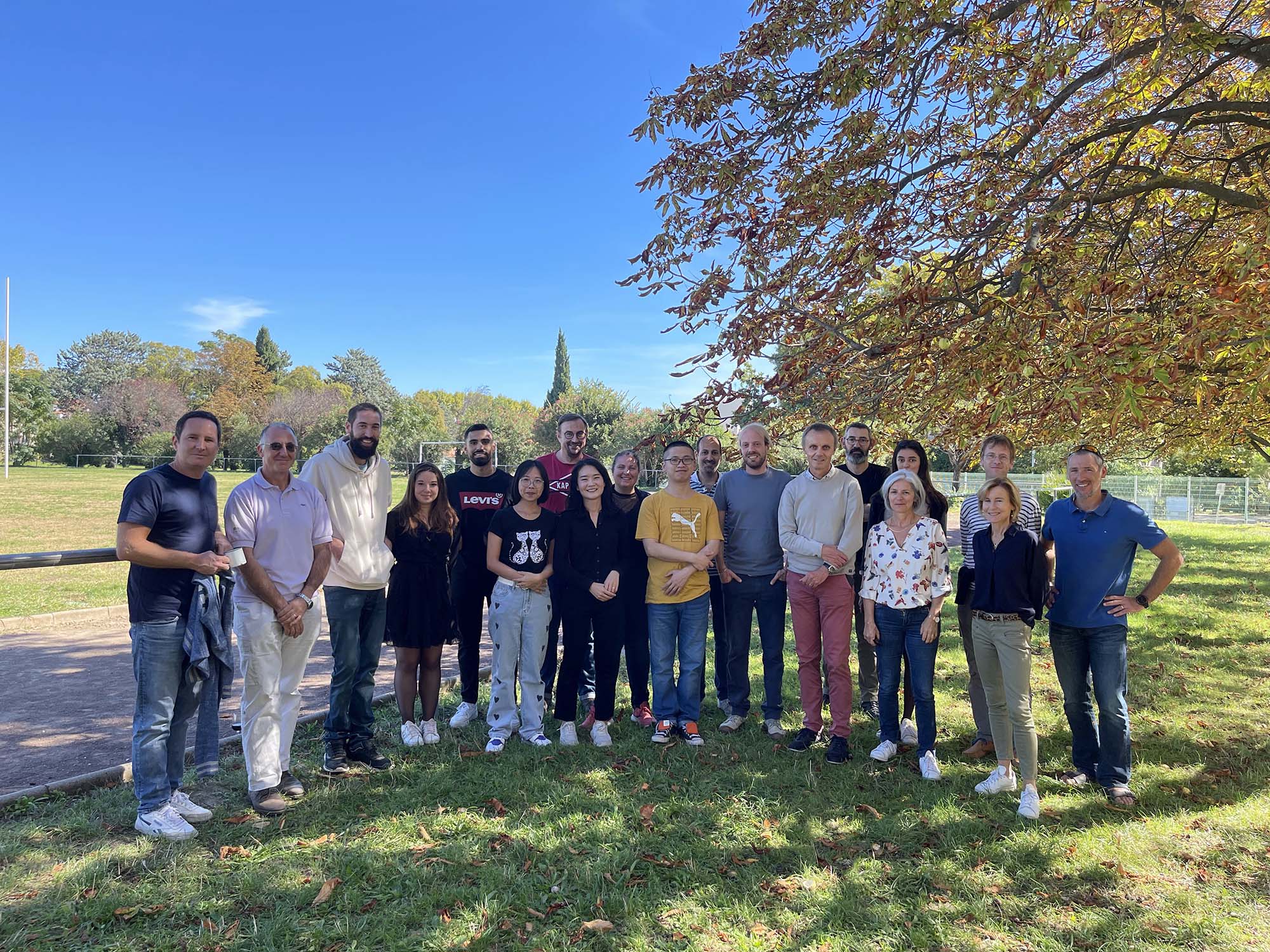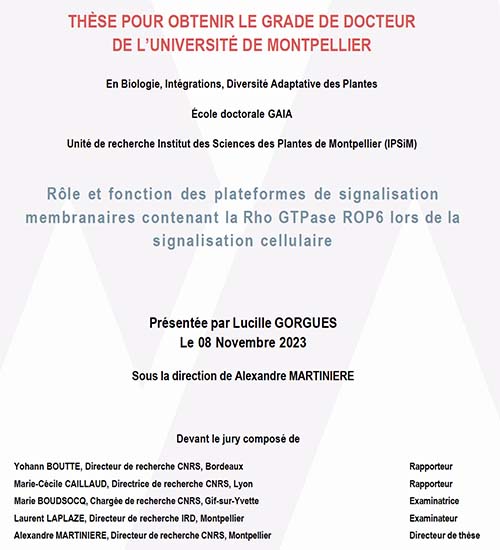

Water, signaling and hydraulic architecture (Aqua)
 Group leader : Christophe Maurel
Group leader : Christophe Maurel
CNRS Research Director
Key words
Aquaporin, Cell signaling, Hydraulics, Phosphorylation, Roots, Water stress, Water transport
Presentation
The Aqua team studies the different modes of water transport in plant tissues. The main objective is to understand how these processes are regulated by water availability, and linked to plant growth and responses to environmental stresses. Supported by national (ANR) and European (ERC) funding, the team combines studies on the model plant Arabidopsis thaliana and maize.
A first axis concerns cell signalling processes. The early mechanisms of plant response to water stress are investigated through molecular (interactomics, proteomics) and high-resolution microscopy approaches. A particular focus is made on the role of membrane nanodomains, reactive oxygen species and protein phosphorylation. These processes are linked to the regulation of aquaporins, membrane channel proteins that facilitate the transport of water across cell membranes.
A second axis concerns the hydraulic architecture of roots. Quantitative genetics, root phenotyping and mathematical modelling are combined to describe the dynamics of root growth and hydraulics. The aim is to understand how they adapt to environmental constraints and water stress in particular, by integrating local and systemic signalling processes.

Team members
Main results
In the last few years, the team has uncovered novel functions and regulations of plant aquaporins. Proteins that physically interact with and regulate root aquaporins have been identified (Bellati et al., 2016). A novel post-translational mechanism that accounts for circadian oscillations of leaf hydraulic conductivity was described (Prado et al., 2019). We also uncovered a dual hydraulic and signaling role of aquaporins during the closing response of stomata to abscisic acid (ABA) (Grondin et al., 2015; Rodrigues et al., 2017). Here, aquaporins contribute to the signalling pathway of this stress hormone by facilitating the entry of hydrogen peroxide in the guard cell. The reactive oxygen species are also crucial during the early signalling responses of root cells to osmotic stress (Martinière et al., 2019).
Quantitative genetic approaches have revealed new components of root hydraulics. A gene that encodes a protein kinase and regulates the root water permeability in response to combined oxygen limitation and potassium sufficiency identifies a novel mechanism for plant response to flooding stress (Shahzad et al., 2016). In addition, a transcription factor controls xylem vessel differentiation and determines a trade-off between abiotic and biotic stress resistance in Arabidopsis (Tang et al., 2018). These results reveal an unsuspected capability of plants to perceive and adapt to multiple environmental constraints. Finally, a coordinating role of ABA in the response of root hydraulic architecture to water deficit was recently uncovered (Rosales et al., 2019).
Significant publications
More than 30 articles in 5 years such as….
Rishmawi L, Bauget F, Protto V, Bauland C, Nacry P, Maurel C✉ (2023) Natural variation of maize root hydraulic architecture underlies highly diverse water uptake capacities. Plant Physiol., (accepted)
Smokvarska M, Bayle V, Maneta-Peyret L, Fouillen L, Poitout A, Dongois A, Fiche J-B, Gronnier J, Garcia J, Höfte H, Nolmann M, Zipfel C, Maurel C, Moreau P, Jaillais Y, Martinière A✉ (2023) The receptor kinase FERONIA regulates phosphatidylserine localization at the cell surface to modulate ROP signaling. Sci. Adv.![]() , 9(14):eadd4791
, 9(14):eadd4791
Boursiac Y, Pradal C, Bauget F, Lucas M, Delivorias S, Godin C, Maurel C✉ (2022) Phenotyping and modeling of root hydraulic architecture reveal critical determinants of axial water transport. Plant Physiol., 190(2):1289-1306
Calvo-Polanco M, Ribeyre Z, Dauzat M, Reyt G, Hidalgo-Shrestha C, Diehl P, Frenger M, Simonneau T, Muller B, Salt DE, Franke RB, Maurel C, Boursiac Y✉ (2021) Physiological roles of Casparian strips and suberin in the transport of water and solutes. New Phytol., 232(6):2295-2307
Martinière A✉, Zelazny E (2021) Membrane nanodomains and transport functions in plant. Plant Physiol., 187(4):1839-1855
Pascut FC*✉, Couvreur V*✉, Dietrich D*, Leftley N, Reyt G, Boursiac Y, Calvo-Polanco M, Casimiro I, Maurel C, Salt DE, Draye X, Wells DM, Bennett MJ, Webb KF (2021) Non-invasive hydrodynamic imaging in plant roots at cellular resolution. Nat. Commun., 12:4682
Smokvarska M*, Charbel F*, Platre MP*, Fiche J-B, Alcon C, Dumont X, Nacry P, Bayle V, Nollmann M, Maurel C, Jaillais Y, Martinière A✉ (2020) A plasma membrane nanodomain ensures signal specificity during osmotic signaling in plants. Curr. Biol., 30(23):4654-4664.e4
Maurel C✉, Nacry P (2020) Root architecture and hydraulics converge for acclimation to changing water availability. Nat. Plants, 6(7):744-749
Rosales MA, Maurel C, Nacry P✉ (2019) Abscisic acid coordinates dose-dependent developmental and hydraulic responses of roots to water deficit. Plant Physiol., 180(4):2198-2211
Martinière A*✉, Fiche J-B*, Smokvarska M, Mari S, Alcon C, Dumont X, Hematy K, Jaillais Y, Nollmann M, Maurel C (2019) Osmotic stress activates two reactive oxygen species pathways with distinct effects on protein nanodomains and diffusion. Plant Physiol., 179(4):1581-1593
Prado K, Cotelle V, Li G, Bellati J, Tang N, Tournaire-Roux C, Martinière A, Santoni V, Maurel C✉ (2019) Oscillating aquaporin phosphorylations and 14-3-3 proteins mediate the circadian regulation of leaf hydraulics. Plant Cell, 31(2):417-429
Tang N, Shahzad Z, Lonjon F, Loudet O, Vailleau F, Maurel C✉ (2018) Natural variation at XND1 impacts root hydraulics and trade-off for stress responses in Arabidopsis. Nat. Commun., 9:3884
Rodrigues O, Reshetnyak G, Grondin A, Saijo Y, Leonhardt N, Maurel C, Verdoucq L✉ (2017) Aquaporins facilitate hydrogen peroxide entry into guard cells to mediate ABA- and pathogen-triggered stomatal closure. Proc. Natl. Acad. Sci. USA, 114(34):9200-9205
Shahzad Z, Canut M, Tournaire-Roux C, Martinière A, Boursiac Y, Loudet O, Maurel C✉ (2016) A potassium-dependent oxygen sensing pathway regulates plant root hydraulics. Cell, 167(1):87-98.e14
Collaborations
Funding
MIRGA « Architecture et croissance du système racinaire de maïs » (2016-2020).
An ANR project that involves, in addition to the Aqua team, the laboratory of Agroecology (INRA Dijon) and the plant biotechnology company Biogemma.
APLIM “Advanced Plant Life Imaging and Metrology” (2016-2020).
This contract is financed by the Agropolis Foundation. It aims to develop nuclear magnetic resonance techniques (NMR, MRI, nanoprobes) in plants and investigate their responses to abiotic and biotic stresses. It involves several institutes of Montpellier, specialized in plant sciences, physics and chemistry.
HyArchi “Targeting Root Hydraulic Architecture to improve Crops under Drought”(2018-2023)
This ERC Advanced project uses maize as a model cereal to study how root system architecture, its hydraulic properties and its environmental plasticity contribute to water uptake and plant resistance to drought.
TURGOMAP “Towards a mapping of turgor pressure in plant tissues “ (2018 – 2020)
A CNRS interdisciplinary program assembling several research groups from Montpellier, Lyon and Grenoble.
ABAqua “ABA-dependent control of plant hydraulics in plant acclimation to water deficit” (2019- 2022)
An ANR-DFG project that involves, in addition to the Aqua team, the Technische Universität München (Prof. Erwin Grill’s group).
CellOsmo “ Membrane nanodomains: Role in osmotic signaling” (2020-2024)
An ANR project supporting early stage researchers.
Former team members

Guowei Li, Shandong Academy of Agricultural Sciences, Jinan, China : swzxliguowei@shandong.cn
Karine Prado, Carnegie Institution for Science, Stanford, USA : kprado@carnegiescience.edu
Alexandre Grondin, IRD, Montpellier : alexandre.grondin@ird.fr
Olivier Rodrigues, Texas A&M University, USA: olivier-rodrigues@laposte.net
Zaigham Shahzad, University of Glasgow, UK : Zaigham.Shahzad@glasgow.ac.uk
Jorge Bellati, Montpellier : jbellati@gmail.com
Ning Tang, Wuhan University, China: tangningwww@163.com
Chloé Champeyroux, ETH, Zürich, Switzerland: chloe.champeyroux@biol.ethz.ch
Monica Calvo, Montpellier : mcalvopolanco@gmail.com
Miguel Rosales, IRNAS-CSIC, Sevilla, Spain: mrosales@irnas.csic.es





